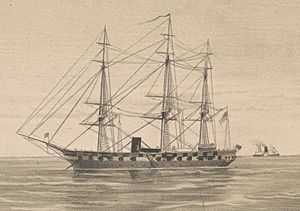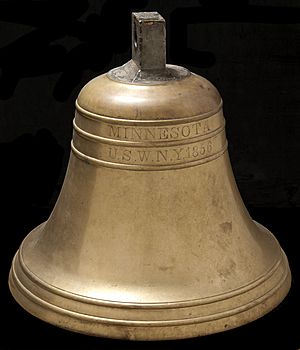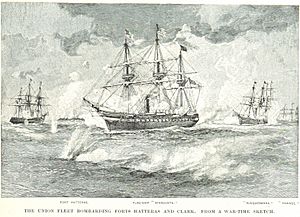USS Minnesota (1855) facts for kids

Minnesota at Hampton-Roads in 1862
|
|
Quick facts for kids History |
|
|---|---|
| Name | USS Minnesota |
| Namesake | The Minnesota River |
| Builder | Washington Navy Yard, Washington, D.C. |
| Laid down | May 1854 |
| Launched | 1 December 1855 |
| Sponsored by | Susan L. Mann |
| Commissioned | 21 May 1857 |
| Decommissioned | 2 June 1859 |
| Recommissioned | 2 May 1861 |
| Decommissioned | 16 February 1865 |
| Recommissioned | 3 June 1867 |
| Out of service | Placed in ordinary 13 January 1868 |
| Recommissioned | 12 June 1875 |
| Out of service | Loaned to Massachusetts Naval Militia October 1895-August 1901 |
| Fate | Sold August 1901; later burned |
| General characteristics | |
| Type | Screw frigate |
| Displacement | 3,307 long tons (3,360 t) |
| Length | 264 ft 9 in (80.70 m) |
| Beam | 51 ft 4 in (15.65 m) |
| Draft | 23 ft 10 in (7.26 m) |
| Propulsion | Steam engine |
| Sail plan | Ship Rig |
| Speed | 12.5 knots |
| Complement | 646 officers and enlisted |
| Armament |
|
The USS Minnesota was a large wooden warship that used both steam power and sails. She was called a screw frigate because she had a propeller (screw) to help her move. Launched in 1855, she was one of the most powerful ships of her time.
Minnesota first served in East Asia for two years. Later, she played a very important role in the American Civil War. She was the main ship, or "flagship," for the Union Navy's efforts to block Confederate ports. During the famous Battle of Hampton Roads in 1862, Minnesota was badly damaged. However, she was repaired and continued to serve. She even helped in the Second Battle of Fort Fisher. Minnesota served the United States Navy until 1898. She was eventually sold and burned to get back her metal parts.
Contents
Building and Early Missions
The Minnesota was built at the Washington Navy Yard in Washington, D.C.. Her construction began in May 1854. She was officially launched into the water on December 1, 1855. Susan L. Mann was her sponsor, which is like a godmother for a ship. The ship was ready for duty, or "commissioned," on May 21, 1857. Captain Samuel Francis Du Pont was her first commander.
The ship was named after the Minnesota River. Her sister ships were also named after rivers. These included the Wabash, Colorado, Merrimack, and Roanoke. The Merrimack later became the famous Confederate ironclad CSS Virginia.
Minnesota left Norfolk, Virginia, in July 1857. She carried William Bradford Reed, who was the U.S. Minister to China. During her time in East Asia, she visited many major ports in China and Japan. She then brought Minister Reed back home with a new trade agreement called the Treaty of Tianjin. When she arrived in Boston, Massachusetts, in June 1859, Minnesota was taken out of service, or "decommissioned." She stayed out of service until the American Civil War began in April 1861.
Minnesota in the Civil War
Minnesota was put back into service on May 2, 1861. Captain G. J. Van Brunt was in command. She became the main ship for the Atlantic Blockading Squadron. This squadron worked to stop supplies from reaching the Southern states. She arrived at Hampton Roads, Virginia, in May. Soon after, she captured several enemy ships.
Minnesota led a combined Army and Navy attack against two important Confederate forts. These forts were located at Hatteras Inlet, North Carolina. On August 28, 1861, the Union ships began firing on Fort Clark. The Confederate soldiers had to leave the fort. The next day, the ships focused their fire on Fort Hatteras. The attack was so strong that the Confederates had to surrender.
When Flag Officer Louis M. Goldsborough took command of the North Atlantic Blockading Squadron, he chose Minnesota as his flagship. William B. Cushing, who later became famous for sinking a Confederate ironclad, also served on the Minnesota.
Battle of Hampton Roads
On March 8, 1862, while blocking the port at Hampton Roads, Minnesota saw three Confederate ships. These were the Jamestown, Patrick Henry, and the ironclad Virginia. The Virginia was actually the former USS Merrimack, rebuilt with iron plates. Minnesota quickly prepared to fight these ships in what became the Battle of Hampton Roads. However, about 1.5 miles from Newport News, Minnesota got stuck in the mud.
Meanwhile, the Virginia attacked other Union ships. She sank the Cumberland and forced the Congress to surrender and burn. Then, Virginia and her allies fired on Minnesota. This caused damage and injuries to her crew. But Minnesota's powerful guns fought back and forced the Confederate ships to leave. As evening came, the Virginia went back towards Norfolk.
The force from Minnesota's own guns pushed her even deeper into the mud. Tugs tried all night to pull her free, but they couldn't. However, during the night, the famous Union ironclad USS Monitor arrived. Captain Gershom Jacques Van Brunt of the Minnesota wrote that everyone felt they had a friend who would help them. Early the next morning, the Virginia returned. The Monitor bravely steamed between Minnesota and the Virginia, firing its guns. Neither ship seemed to be badly hurt.
The Virginia then tried to attack Minnesota again. Minnesota fired all her guns in return. A shell from Virginia went through parts of Minnesota and caused a small fire, which was quickly put out. Around midday, the Virginia left again. The Union Navy then worked to free Minnesota. The next morning, a steamer and several tugs finally pulled the frigate free. She then went to Fort Monroe for quick repairs.
Seven African-American sailors worked the front gun on the Minnesota during this battle. These brave men included William Brown, Charles Johnson, George Moore, George H. Roberts, George Sales, William H. White, and Henry Williams. During the two-day battle, Minnesota fired many rounds from her powerful guns.
Battles of Fort Fisher
For the next few years, Minnesota remained the flagship of the North Atlantic Blockading Squadron. In April 1863, four of Minnesota's sailors earned the Medal of Honor. They were Robert Jordan, Robert B. Wood, Henry Thielberg, and Samuel Woods. They earned this honor while on a different ship, the USS Mount Washington. In April 1864, while anchored, Minnesota was attacked by a Confederate torpedo boat. The torpedo exploded nearby but did not damage the ship.
On December 24 and 25, Minnesota took part in a major attack on Fort Fisher. This fort protected Wilmington, North Carolina, a very important port for the Confederacy. Minnesota positioned herself about a mile from the fort. She fired a huge number of shells at the Confederate stronghold. However, the Union general, Benjamin F. Butler, pulled his troops back.
Three weeks later, the Union Navy returned with new troops. This time, General Alfred Terry was in command. A landing party of 240 men from Minnesota joined the attack. Their ship provided covering fire. This attack was successful! It closed Wilmington, which was a big loss for the Confederacy.
During the Second Battle of Fort Fisher, nine sailors and Marines from the Minnesota earned the Medal of Honor. They were part of the landing party that stormed the fort. These brave men were:
- Landsman Gurdon H. Barter
- Seaman David L. Bass
- Ordinary Seaman Thomas Connor
- Ordinary Seaman Thomas Harcourt
- Seaman Charles Mills
- Corporal John Rannahan
- Private John Shivers
- Private Henry A. Thompson
- Ordinary Seaman Franklin L. Wilcox
Later Years of Service
After the Civil War, Minnesota was taken out of service in February 1865. She was put back into service in June 1867. She then took a trip to Europe with young naval students called midshipmen. In January 1868, she was placed in storage at the New York Navy Yard.
Minnesota was put back into service again in June 1875. She stayed at the New York Navy Yard. Here, she became a training ship for young sailors learning about naval guns and other skills.
From 1881 to 1884, Captain Stephen Luce commanded Minnesota. He later started the Naval War College in 1884. The warship also took part in the opening ceremonies for the Brooklyn Bridge on May 24, 1883.
Three more sailors from Minnesota received the Medal of Honor during this time. Captain of the Top William Lowell Hill and Ship's Cook Adam Weissel saved fellow sailors from drowning in 1881. Second Class Boy John Lucy was honored for his actions during a fire at the Castle Garden immigration building in 1876.
In October 1895, Minnesota was loaned to the Massachusetts Naval Militia. She served with them until August 1901. Then, she was sold to a company in Boston. Eventually, she was burned in Eastport, Maine, to salvage her valuable iron parts.
Images for kids




